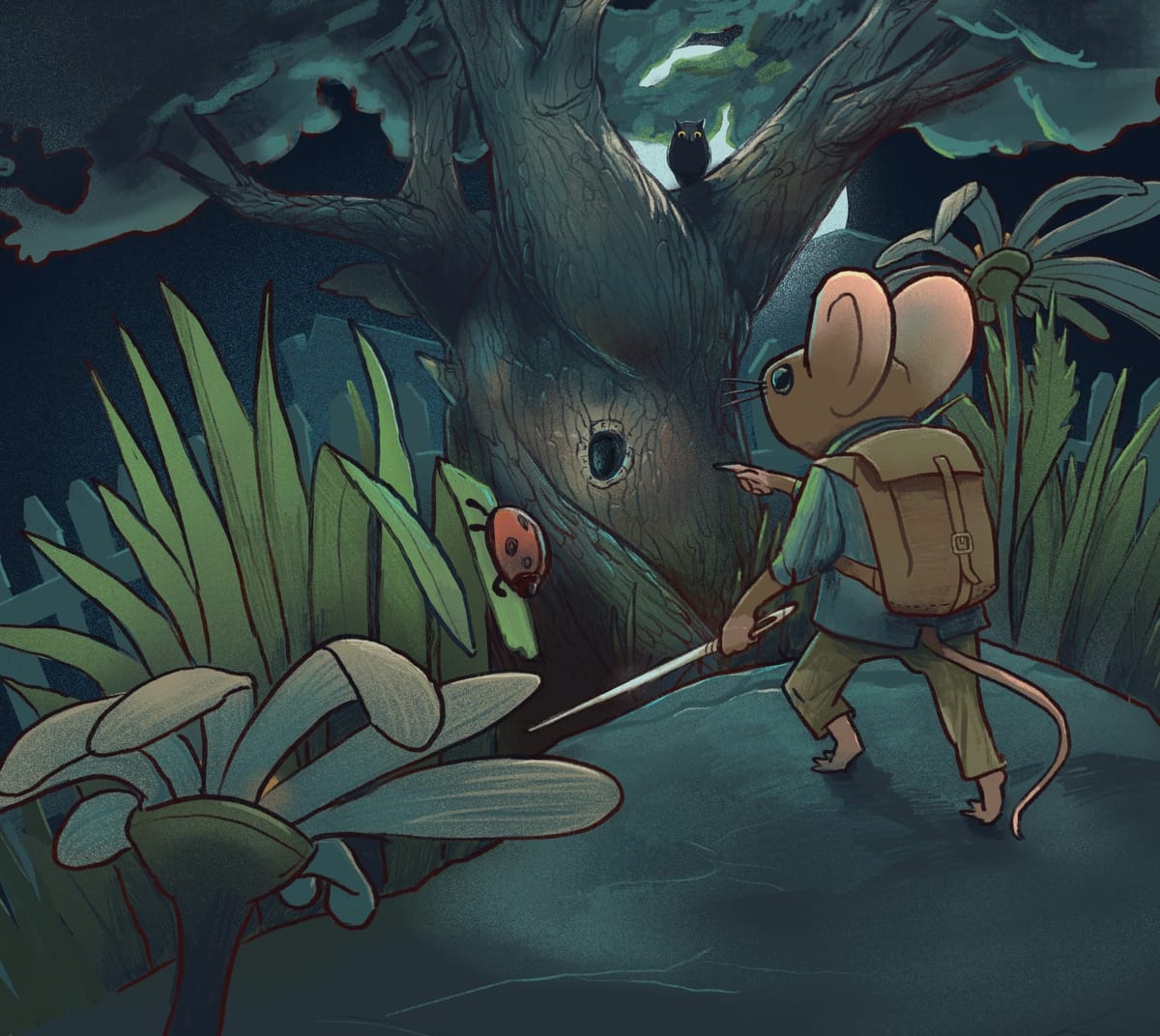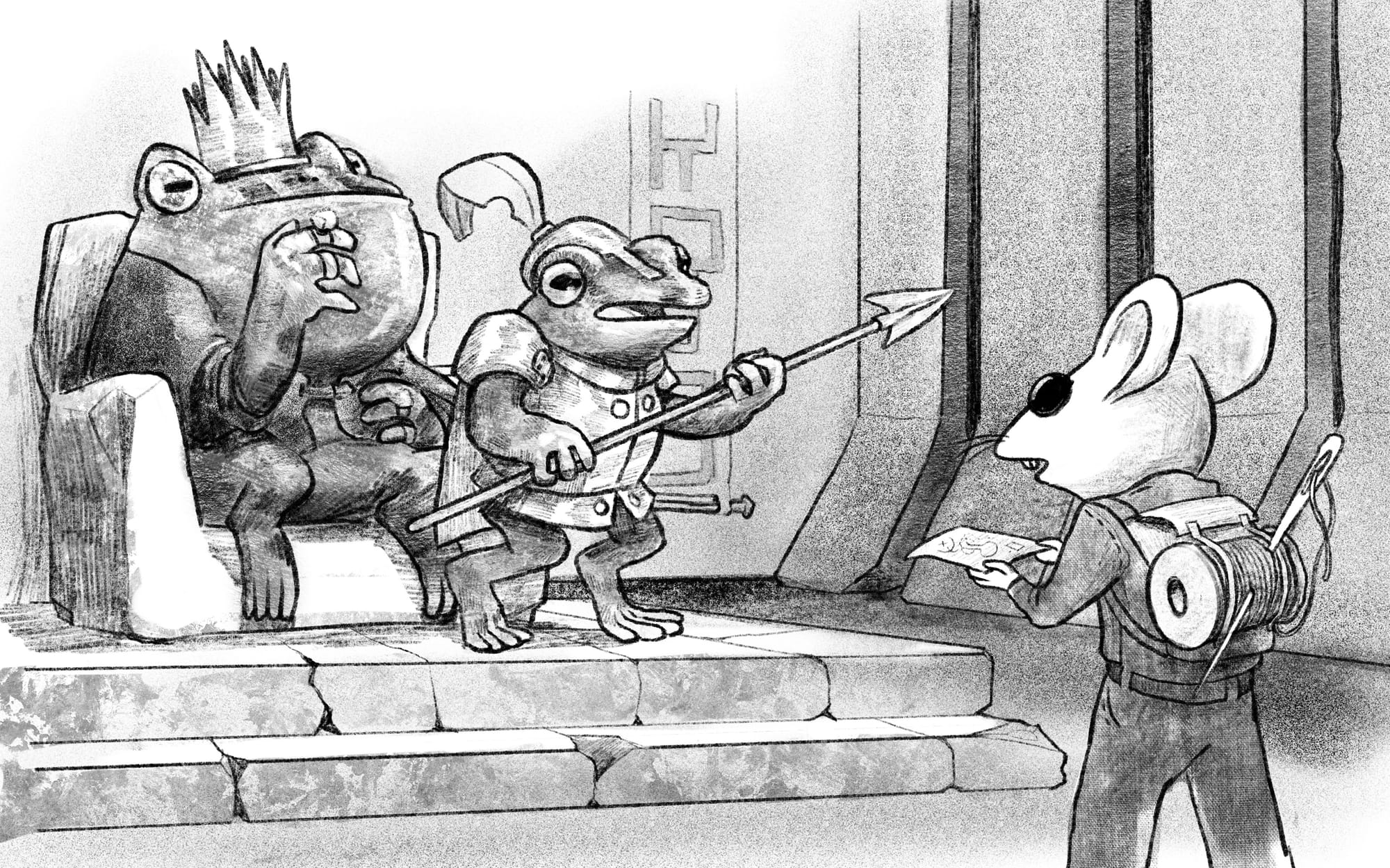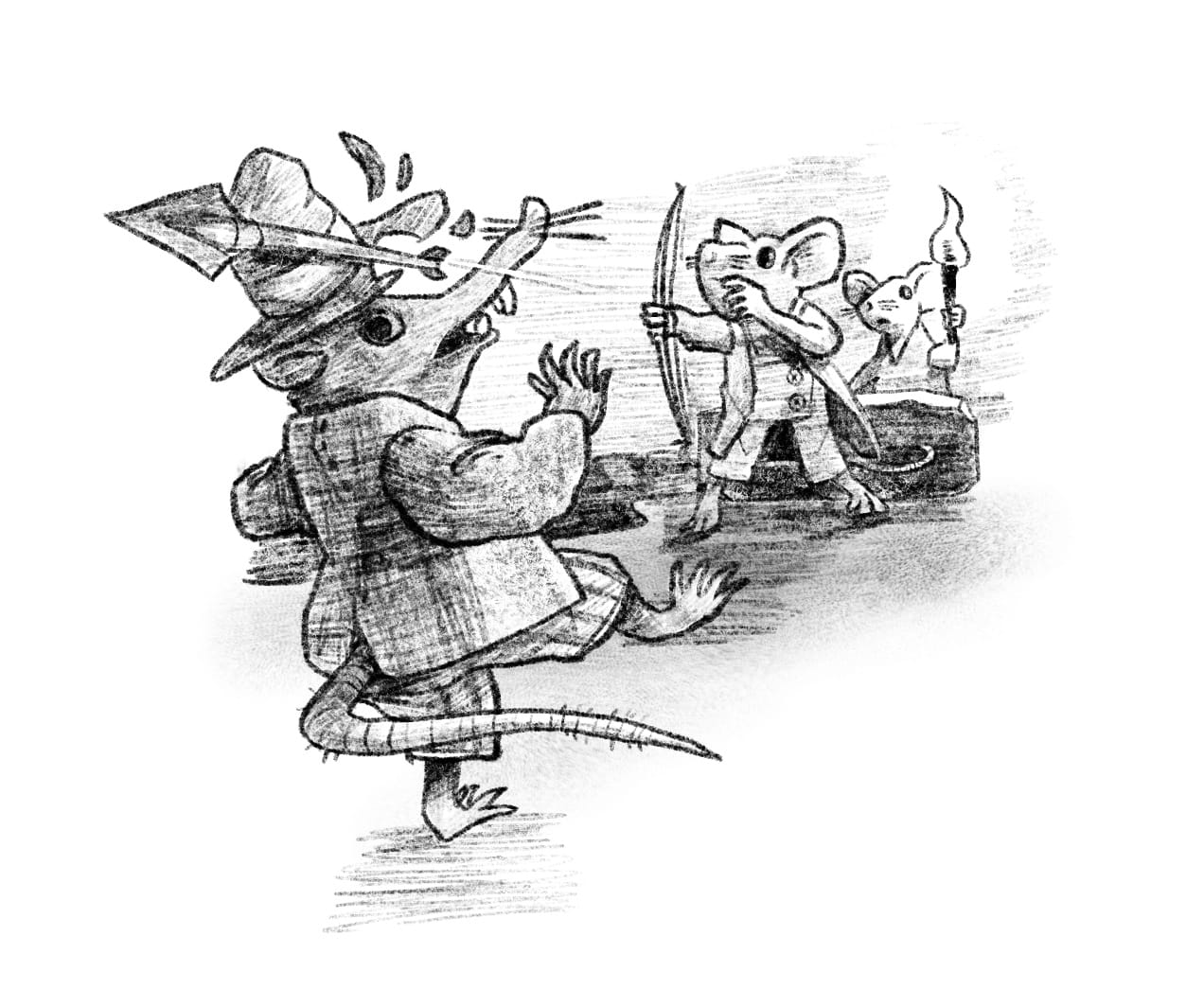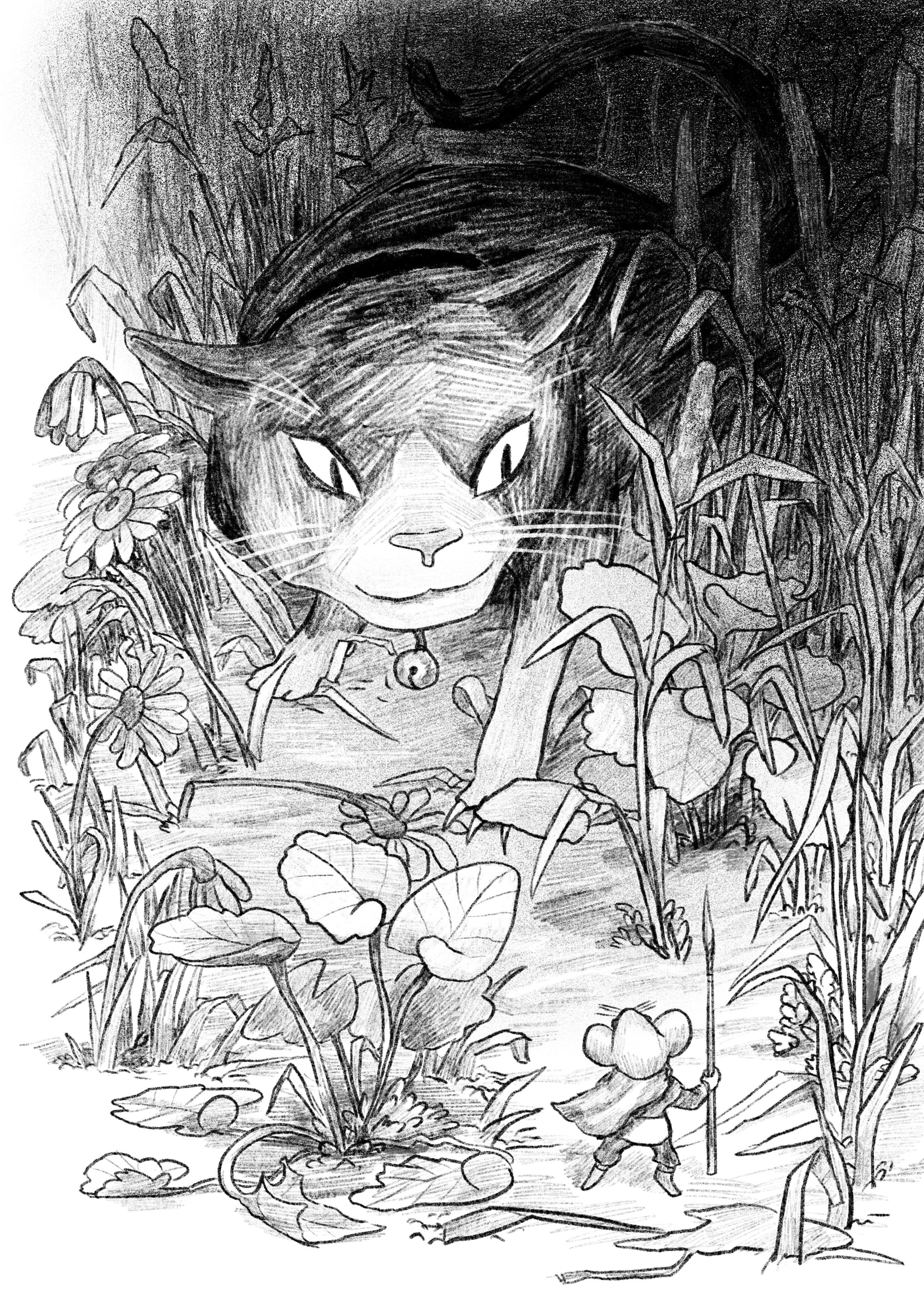
‘Let’s do a drawing,’ says Ada, my three-and-a-half-year-old daughter.
I ask her what she wants to draw.
‘An adventure,’ she says.
She gets out various bits of coloured paper and pens and starts drawing shapes on each. This isn’t the first time this has happened. I take a couple of scraps of paper and fold them in half, drawing us a couple of mice on them. We’re going to play the ‘fighting mouse game’ and Ada will be running it.
Mausritter is the most successful game in my house. Not only can I run games for my family, but the fact my daughter can run a version of her own invention makes it the thing we play the most here. In her homebrew version there might be less dice, less ‘structure’, but she does stick a silver star onto our paper mice at the end – something which might be the best levelling up feeling I’ve ever had.
We’d started off playing Honey In The Rafters, the introductory adventure in Mausritter’s boxed set about sugar cultist mice and a cursed bee hive. We swapped out one of the magic items (a potent boiled sweet giving you advantage on rolls) for Haribo sweets, which she put directly into her inventory without any explanation required from us. Until it was time to use it of course.
Now, this story isn’t a particularly special one, in fact it’s surprisingly common amongst those in the Mausritter community. This is a game that, despite its often frankly brutal nature, easily lends itself to being played both with children and amongst families. Moreover it’s a game with a hugely supportive community online, just last year the Mausritter Library surpassed 500 adventures, zines, bestiaries and myriad other useful sword-and-whiskers tools.
The curator of that library is Matthew Morris, also known as ManaDawn Tabletop Games, who also has contributed over 70 of his own Mausritter modules to its virtual shelves. Like all good OSR stories, Morris’s Maus-sized adventures began with a murder. After he had created a Brian Jaques’ Redwall style campaign for his Dungeons & Dragons group, a winged and clawed epiphany landed in front of Morris.
‘I was looking out my back window and I saw a field mouse get into a scuffle with a Bluejay. I watched this Bluejay violently murder a mouse,’ says Morris, ‘and I was like, “that was intense.” And then it hit me. There’s a game where you’re not playing in a medieval world of mice where humans don’t exist, you play a real size mouse in a human world that is brutal and violent.’
This was the start for Morris’ foray into the world of Mausritter -and ours too- as we discover how the game came into being and what makes it such a well-loved game by its community.

Isaac Williams is the creator of Mausritter. Well, sort of. ‘Mausritter flowed out of my home game in a way that feels like I didn’t really design it,’ admits Williams. For him, it just arose naturally out of another title – the adventure board game Mice & Mystics. ‘I was playing a campaign game and it had run its course. I threw it out to the group that I was having fun – but thinking to myself that there’s only so much you can do in a board game. So often I wanted to solve problems in ways other than punching the rat in the face.’
‘While we were playing that game and enjoying the cute mice aspect of it – I was tinkering away in the background and waiting for the right moment to spring a mouse themed roleplaying game on my friends.’
To start with Williams took Chris McDowall’s acclaimed RPG Into The Odd, wrote a new, mouse flavoured, background table and added what would become Mausritter’s now famous inventory system, from there Williams just ‘built up more mechanics at the table.’
Mausritter first landed as a free to download PDF zine, which caught the eye of Portuguese game publisher Andre Novoa. Whilst only releasing their first title in 2020 Novoa’s company Games Omnivorous, have quickly earned a reputation for picking out the best of the indie scene before turning them ludicrously nice physical products.
Naturally Williams turned him down, only acquiescing some months later when Novoa approached him again after the first release of Honey In The Rafters.
Thankfully so, as the resulting Mausritter: Boxed Set is a thing of beauty. Tokens, character sheets, a GM screen and a lovely slim hardback rulebook (complete with mouse-hole cut-out) are all perfect for a game that has become synonymous with introductory roleplaying. Still it wasn’t the lavishness that convinced Williams to go with it however, but something closer to his original source materials for the game.
‘What really convinced me was when I was reading a Little Golden Book to my niece. The form factor of those books is really small and compact. It made me think that yes, we could make a small hardback book – and it’s a little over the top but it’s really nice.’
‘I didn’t come to it via Redwall and I think that’s quite important, I was never really into those books. They never really grabbed me. I think the cultural touchpoints I see with Mausritter are much more Beatrix Potter or the Brambly Hedge book series,’
Brambly Hedge, a series of books about mice living in the pastoral English countryside where major events include things like dragging a big apple back home at Christmas, is a particularly good guide to understanding the environment that Mausritter operates within.
‘They’re definitely small mice in a big world,’ says Williams, ‘the way I see Mausritter is that this is about the mice who aren’t able to live in that civilised society.’
These references feel clear in the game, as does the world of The Borrowers – where scale and secrecy are the main drivers for our heroes, as survival isn’t certain. Anyone familiar with these stories will know how playing with scale is fun and thrilling with the danger as obvious as the food chain you’re staring up at.

‘I was a history nerd before games,’ says Morris. When he came to Mausritter he was running a game for a friend who wanted to try Dungeons & Dragons for the first time. That game has now been running for over 90 sessions over the last three years – much of it consisting of the 70-plus adventures and extras Morris has penned.
‘I like connected universes,’ he continues, ‘when I started playing Mausritter there were only around three supplements for it. And because I felt like I was “in on the ground floor” I started tracking everything going forward. So that’s what I have done for the last three years.’
Of course, as the Mausritter library shows, Morris and Williams aren’t the only ones writing adventures for the game. I asked what they think makes it such an appealing game to write modules for.
‘It’s a couple of things,’ Morris explains, ‘with the key being the ease of the system. You’re not encumbered by a 300 page rulebook, it’s a one page spread. But the other thing that’s so intriguing about Mausritter is that you could be walking through a field on a hike, or next to a barn, in a subway or in a McDonalds of all things and, for a human it’s just the mundane. But if you’re a six inch tall mouse mouse trying to find a magical needle to defeat a fairy queen – it’s such a large adventure site and our world is so applicable.’
‘I walk by adventure sites every single day,’ he adds.
Williams puts some of the community growth down to how quickly, and deliberately, he encouraged people to make their own content for the game. The third party licence was released almost immediately, alongside discord communities centred on the game, and he knew there would be someone, like Morris out there who would champion his game.
Williams’ reasons for that belief were simple, ‘There’s so much material that you can play with in a classic D&D environment, there’s 50 years of material you can draw on. But there’s very little material that you can draw on for playing as a mouse.’
So the development of community materials was partly out of necessity. ‘You kind of have to invent some new things to put in your adventure,’ he says laughing, ‘there’s a lot of blank space in Mausritter that calls out to be filled, deliberately.’
This rulebook says this in fact – that some of the gaps are deliberate (and some aren’t). So without trying to get too ‘TTRPG Jazz’ about it, I ask Williams for an example of something he deliberately left out of the game.
‘I think a really deliberate gap I left is the role of humans in the world of Mausritter,’ says Williams after a little pause, ‘they’re not mentioned at all in the rulebook. That’s meant to be a space that the reader should fill.’
In published adventures this most often translates to humanity being something of a a ghostly presence, felt through the detritus we have left behind, or as in Williams’ own Mausritter games, humans existing, but being totally oblivious to the small world of adventure that is happening beneath their feet.
Chris McDowall, the creator of the Into The Odd system that sits at Mausritter’s core (think three stats, D20, roll under, and everything hits because HP is already an abstraction of how good you are at dodging) echoes that theory of the game’s success.
‘No matter how good a rules system is, a game lives or dies by its ability to inspire the imagination of the reader. You see this with games like MÖRK BORG and Mothership that are built around settings with an incredibly strong identity, they immediately get the reader to imagine what sort of adventures could happen in these worlds,’ explains McDowall,
‘Mausritter does that too, but it's even better because you can glance anywhere outdoors and find inspiration for a Mausritter game. Landscapes and litter can give you your next interesting location, while local wildlife can serve as your monster manual.’
Williams has another, complementary, theory. ‘It doesn’t expect too much of the author,’ he says.
Which might be true, much of the adventure writing is quite terse and quick, with the sense that we’re meant to fill in the gaps as we go. Maybe this is one of the reasons it plays so well at the table – there’s no boring homework, just a good time on a small scale.

As systems go Into The Odd is a fairly brutal one. It’s minimal and, because it takes away the ‘to hit’ roll, heading into combat as a first course of action can easily end with death. There is a misunderstanding amongst many game designers, GMs and even some players that new players find high levels of threat very off-putting Morris believes that this stems from the prevailing culture of D&D5E, which encourages players to invest a great deal of time and effort creating characters and backstories in the expectation that you’re going to spend a lot of time in their company. There’s a tension between this and the lethality of OSR style games like Mausritter.
‘It is very high stakes and the chances are that your mouse is going to die,’ says Morris, ‘but that’s where there’s some of the excitement.’
Still, in his game there’s only been a handful of deaths, because as seasoned OSR players will often tell you, that lethality changes the way people approach the game. There’s a world of difference from the Marvel-movie heroism you find in much modern D&D to just being a little mouse armed with a fish hook or a sharp stick. You tend to be more careful without the cape.
But if the game is inherently dangerous, risky and violent – what makes it such a good family game? What audience did Williams have in mind when he was writing it?
‘When I was making it, it was just for me and my friends,’ he explains, ‘which is why it’s so fun to see it be played by lots of other people. My favourite group of people who I see playing it are parents and their kids – I love that so much. It’s great to see Mausritter being used to introduce kids to roleplaying games.’
Williams goes on to say that his experience of getting into RPGs was via the B/X Red Box – and having to work out much of it himself. Frankly this doesn’t sound like much fun. While many of us might have similar stories of muddling through something that’s a little too complicated for us at ‘too young’ an age to get into certain aspects of gaming, we might have all benefited from an early introduction to Mausritter.
‘It’s not a game that is designed for kids,’ continues Williams, ‘it can be pretty mean. I think to run it for kids you have to pull your punches some of the time, but they are much more resilient than people give them credit for.’
This is certainly true in my experience. My daughter knows that if the dice don’t go her way, it’ll still be interesting – still most of the enemies just ‘run away’ when they get to zero HP. On the flip side of this she has attacked nearly harmless NPCs with the phrase ‘let’s get him,’ and a certain glee in her eyes. I’m proud of her in these moments of pretending, but I also didn’t know she had it in her.
‘Mausritter really understands that a minimalist system like Into the Odd presents an opportunity to make best use of both the headspace and page count that's been freed up. Simplicity for its own sake is rarely satisfying,’ says McDowall, ‘but it lets you shine a spotlight on other parts of the game. In this case that means filling the book with the flavour of its miniature world and including a generous amount of guidance and content for hexcrawls and dungeons.’

It might be this simplicity that works for younger players. After all, one of the things that everyone loves about Mausritter is summed up with one otherwise uninspiring phrase: inventory management. While most OSR style games have some form of this in their workings, it’s often the thing that gets waved away first. After all who cares about encumbrance? Not many of us, most of the time – it’s the admin between the goblin murder. But here it’s dealt with using physical tokens slotted into the character sheet. Run out of slots? You’ll have to drop something or you’re going to wear your tiny paws out.
Conditions, such as sickness, hunger and exhaustion are also tokens that get carried just like any other item would be. It’s a simple system that stops someone ‘forgetting’ that they’re carrying a horse’s weight in trinkets, and probably can’t just shimmy up that rope.
‘It’s good to make dealing with restrictions fun – which I think is a really important part of playing the style of game that Mausritter is, which is fundamentally about resource management,’ says Williams. ‘If you play D&D it’s HP, rests, and spell uses but in Mausritter it’s almost entirely represented in your inventory whether that’s your torch burning down or spell charges being used up or conditions, it’s all just there on your sheet and it forces you to engage with it.’
These ideas are simple ones that are grasped extremely quickly by players. Young adventurers in particular are quick to understand that you can only carry what you’ve got space for on your character sheet. It’s just another thing that gets out of the way of the setting.
‘It’s also got that level of cuteness,’ says Williams, ‘it’s got lots of empty spaces to fill and that’s great because kids love empty spaces. It’s even got a space on your character sheet to draw your mouse.’
In some ways there’s no difference between spending hours on a character backstory in D&D 5E and the chance to draw your fighting mouse as a child. And the power fantasies that get played out in the average ‘grown-up’ 5E game and those with kids around a Mausritter table are the same too – it’s the offer and promise of real make believe.
For children, living in a world of sometimes clear but boring but at other times confusing rules, the chance to just say what they want and be rewarded for it is no different to when a player does the ‘murder hobo’ thing. Maybe it’s giving them the chance to do what they want for once.
Williams sums it up, ‘a lot of kids' media is patronising – it’s fun to give a kid something that sets them free.’
And with that it’s back to the table for some more drawing of adventures at the dining room table before bedtime.
Mausritter by Isaac Williams is out now published by Games Omnivorous
Tomb of a Thousand Doors: A Mausritter Megadungeon created by Matthew Morris is on order now
This feature originally appeared in Wyrd Science Vol.1, Issue 6 (August '24)

